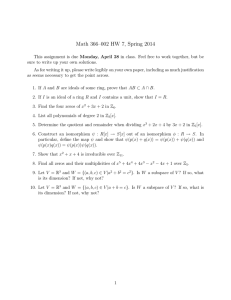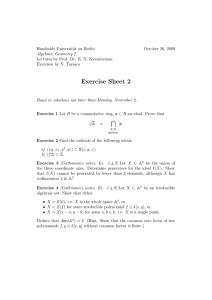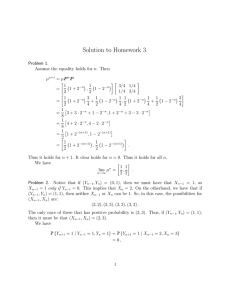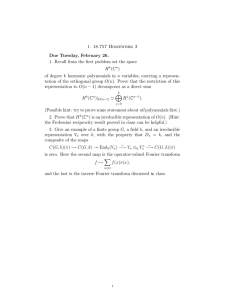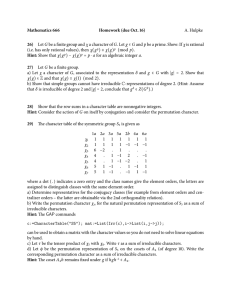Mathematics 666 Homework (due Sep. 11) 6) A. Hulpke
advertisement
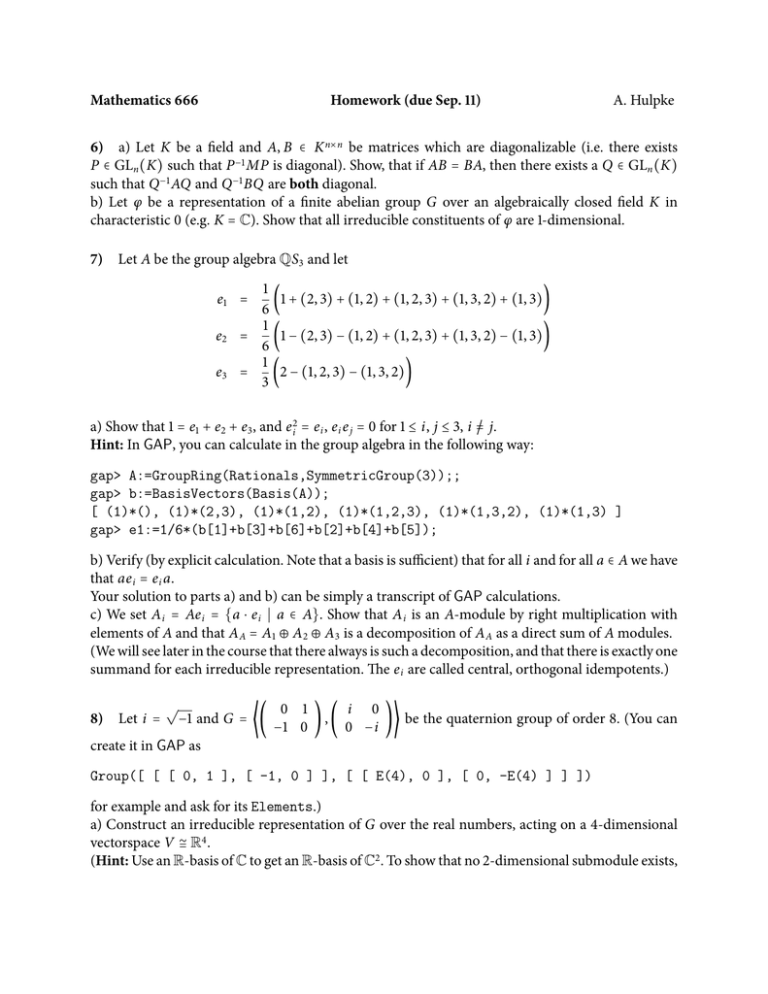
Mathematics 666
Homework (due Sep. 11)
A. Hulpke
6) a) Let K be a field and A, B ∈ K n×n be matrices which are diagonalizable (i.e. there exists
P ∈ GLn (K) such that P −1 MP is diagonal). Show, that if AB = BA, then there exists a Q ∈ GLn (K)
such that Q −1 AQ and Q −1 BQ are both diagonal.
b) Let φ be a representation of a finite abelian group G over an algebraically closed field K in
characteristic 0 (e.g. K = C). Show that all irreducible constituents of φ are 1-dimensional.
7) Let A be the group algebra QS3 and let
1
(1 + (2, 3) + (1, 2) + (1, 2, 3) + (1, 3, 2) + (1, 3))
6
1
(1 − (2, 3) − (1, 2) + (1, 2, 3) + (1, 3, 2) − (1, 3))
=
6
1
(2 − (1, 2, 3) − (1, 3, 2))
=
3
e1 =
e2
e3
a) Show that 1 = e1 + e2 + e3 , and e i2 = e i , e i e j = 0 for 1 ≤ i, j ≤ 3, i =/ j.
Hint: In GAP, you can calculate in the group algebra in the following way:
gap> A:=GroupRing(Rationals,SymmetricGroup(3));;
gap> b:=BasisVectors(Basis(A));
[ (1)*(), (1)*(2,3), (1)*(1,2), (1)*(1,2,3), (1)*(1,3,2), (1)*(1,3) ]
gap> e1:=1/6*(b[1]+b[3]+b[6]+b[2]+b[4]+b[5]);
b) Verify (by explicit calculation. Note that a basis is sufficient) that for all i and for all a ∈ A we have
that ae i = e i a.
Your solution to parts a) and b) can be simply a transcript of GAP calculations.
c) We set A i = Ae i = {a ⋅ e i ∣ a ∈ A}. Show that A i is an A-module by right multiplication with
elements of A and that A A = A1 ⊕ A2 ⊕ A3 is a decomposition of A A as a direct sum of A modules.
(We will see later in the course that there always is such a decomposition, and that there is exactly one
summand for each irreducible representation. The e i are called central, orthogonal idempotents.)
√
0 1
i 0
),(
)⟩ be the quaternion group of order 8. (You can
−1 and G = ⟨(
−1 0
0 −i
create it in GAP as
8) Let i =
Group([ [ [ 0, 1 ], [ -1, 0 ] ], [ [ E(4), 0 ], [ 0, -E(4) ] ] ])
for example and ask for its Elements.)
a) Construct an irreducible representation of G over the real numbers, acting on a 4-dimensional
vectorspace V ≅ R4 .
(Hint: Use an R-basis of C to get an R-basis of C2 . To show that no 2-dimensional submodule exists,
consider images of a nonzero vector (a, b, c, d) in this subspace under different elements of G, and
show that they will yield a basis of at least a 3-dimensional subspace.)
b) Determine the endomorphism ring EndRG (V ).
(Hint: The elements of EndRG (V ) are 4 × 4 matrices that commute with the generators of G. Use
this to deduce conditions on their entires. Then show that every matrix fulfilling these conditions
commutes with G.)
c) By Schur’s lemma EndRG (V ) must be a division ring. Can you identify it?
9) Let M ∈ GLn (C). We consider M as the image of a generator in a representation of the infinite
cyclic group. Let V = Cn be the module associated to this representation. Show that V is a cyclic
module if and only if the characteristic polynomial of M equals the minimal polynomial of M.
10) (GAP) a) Let G = A5 and F = F9 = GF(9). Determine with the MeatAxe (but without
using the MTX.CollectedFactors command) the irreducible FG-modules of dimension 3 up to
isomorphism.
b) Also determine (you may use the MTX.CollectedFactors command here) the irreducible F4 G
modules of dimension 3 up to isomorphism. Compare.
Problems marked with ∗ are bonus problems for extra credit.


